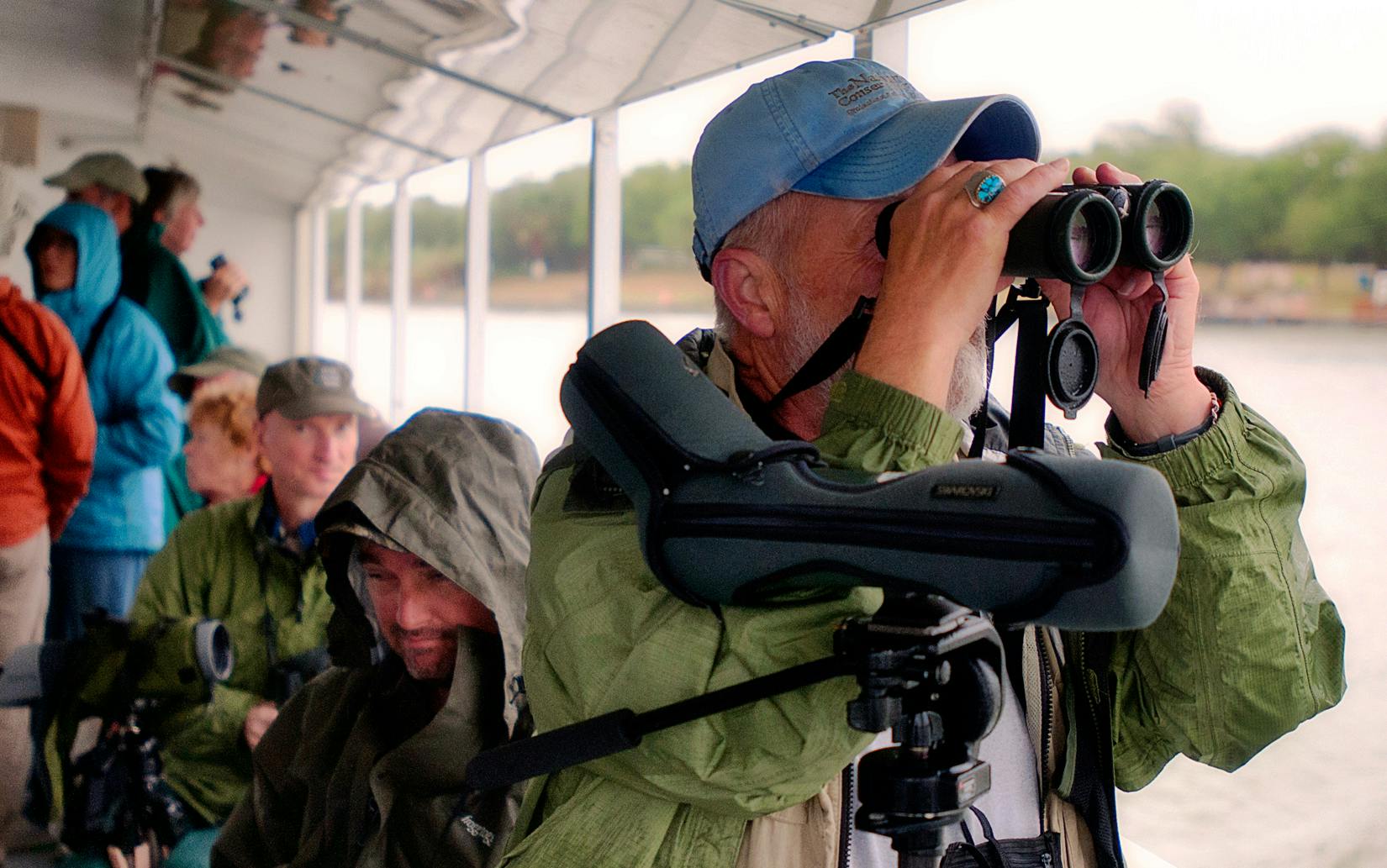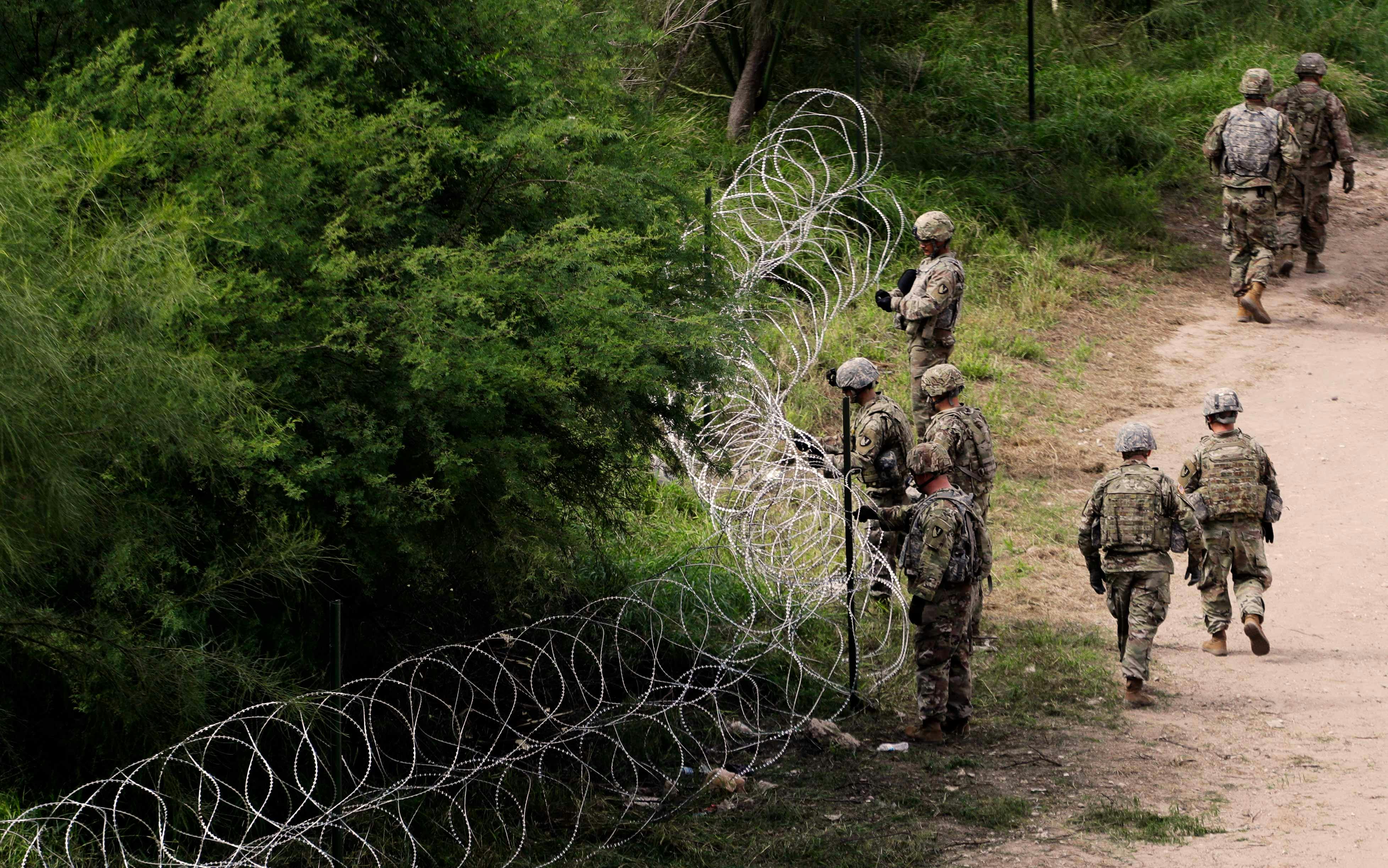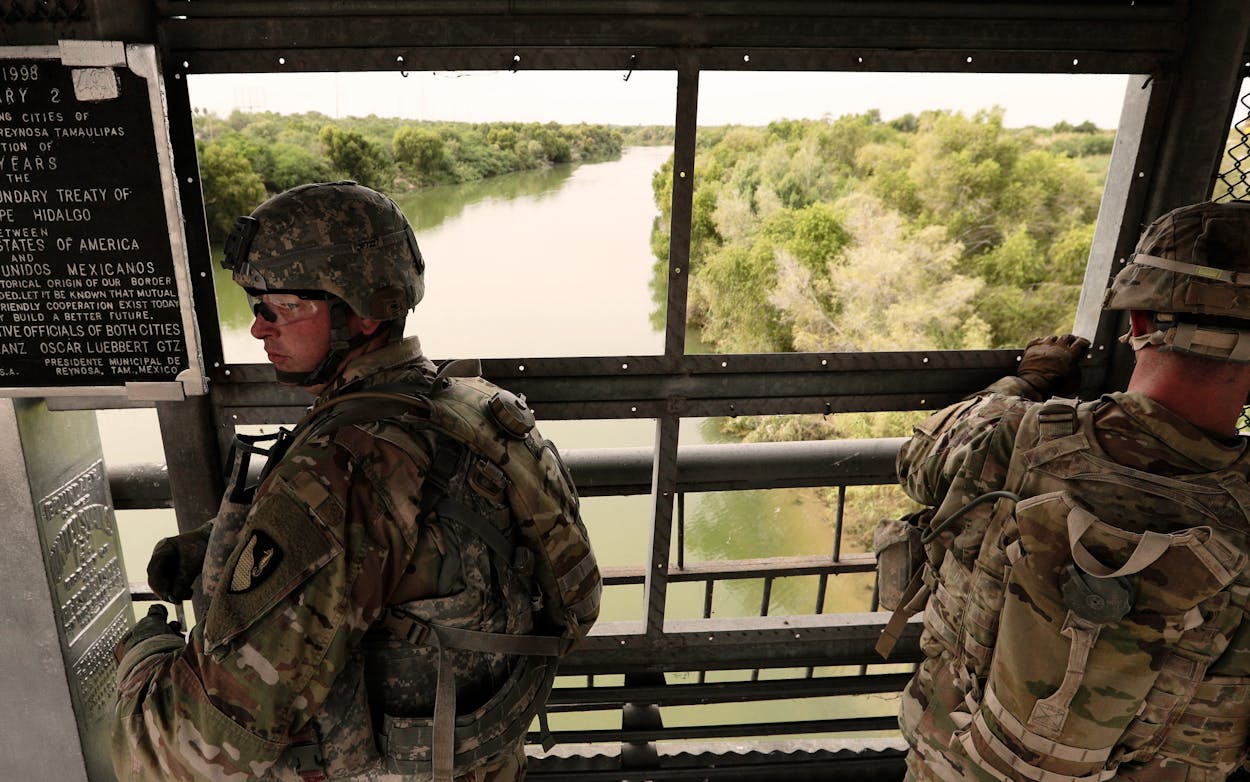The same week in early November when about a thousand U.S. Army troops were deployed to the South Texas town of Donna, the staging site for what was once called Operation Faithful Patriot—the high profile pre-election deployment that President Trump sent to meet a caravan of immigrants marching north from Central America—hundreds of ornithologists converged 25 miles to the east, at the Harlingen Municipal Center, for the 25th annual Rio Grande Valley Birding Festival.
As the soldiers busied themselves installing rows of concertina wire along the river in the shadow of the McAllen-Hidalgo International Bridge, busloads of birders set out before sunrise in search of white-tailed kites, green kingfishers, and black-crested titmice on field trips ranging from South Padre Island to Falcon State Park nearly 150 miles away.
The contrasting missions of the battle-ready troops and the wildlife enthusiasts starkly underlines the complex realities involved in implementing the Trump administration’s priorities for securing the Mexican border. A region intent on protecting its robust ecotourism industry presents political challenges for a president intent on fighting illegal immigration.
Bentsen-Rio Grande Valley State Park has become a battlefield in this conflict. It was an unseasonably chilly and rainy Veterans Day when about 35 birders from all over the country disembarked at the park’s headquarters after an hour-long drive. Most took the opportunity to explore the small surrounding gardens. “Green jay,” someone said, pointing to a nearby treetop. A dozen heads attached to binoculars swiveled in that direction.
“Look back through that opening, and I think you’ll see some motion back in there,” said Sherry Wilson, one of the four trip guides. “Follow the horizontal branch that’s fallen down. There’s an olive sparrow that’s hunkered down in the grass.” The binoculars are reoriented that way.
“There’s a house wren singing on the left, near the building,” said someone else, and several of the birders sauntered that direction to take a look. A short distance away, a few plain chachalaca were moving about a patch of grass near a sidewalk.
We’d spotted three of the roughly 30 bird species that don’t live anywhere in the United States outside of the Rio Grande Valley—and we still hadn’t gotten past the parking lot.
It’s obvious to even fist-time visitors why Bentsen was designated the headquarters of the grandly named World Birding Center (a genius bit of marketing for nine prime birding spots in the Valley). Birders revel in checking new species off their life lists, and a visit to far southern Texas, where almost 500 bird species have been documented, is requisite for completists looking to finish their North American tallies. Birds feed much of the $463 million local ecotourism industry (according to a 2011 Texas A&M University study).

The Valley benefits from being situated where two of the continent’s major migratory bird routes, the Central and Mississippi flyways, overlap. Birds that usually live farther east but hesitate to fly over the expanse of the Gulf of Mexico will skirt the Texas coast as they head south for the winter. It’s a semitropical zone but sits in relatively close proximity to four surrounding habitats: desert to the west, coastal environs to the east, temperate forest to the north, and the tropics to the south. That centrality leads to an unusually rich intermingling of species.
Bentsen state park in particular benefits from the fertility surrounding the Rio Grande. Only a tiny percentage of the Tamaulipan thornscrub landscape native to the Valley still exists. It’s “some of the most diverse plant life in the country, and therefore some of the most diverse birding,” said Tiffany Kertsen, another of the festival guides. Most of it was lost as early settlers of the region arrived to farm and otherwise develop the land, but its preponderance of mesquite trees and varieties of heavy, tall brush remains plentiful within Bentsen’s boundaries. The park extends from the headquarters building a little over a mile to the big river, with 700 of its 766 acres in the floodplain beyond a levee.
It’s no coincidence that so many of the Valley’s best birding spots are similarly situated. The river has long been a lifeline to plants and animals and an important way station along migration routes. Yet the river is also the reason these treasured landscapes are threatened today.
Meandering its way to the Gulf of Mexico, the Rio Grande is an ancient waterway. Its origins in the San Juan Mountains of Colorado date back tens of millions of years. Not until 1848 did Mexicans and Americans agree that it would serve as the boundary between their two nations. Not until 2018 did leaders in Washington decide there needed to be a physical barrier through Bentsen state park to mark that dividing line.
President Trump won election campaigning on the promise that he would build a “big, beautiful” wall along the entirety of the Mexican border. While that vision remains far from reality, Congress passed a $1.3 trillion spending bill last March that included nearly $1 billion for the construction of eight miles of barriers through Starr County and another 25 miles in Hidalgo County, where Bentsen is located. Environmental activists managed to convince lawmakers to leave nearby Santa Ana National Wildlife Refuge undisturbed (at least for the coming fiscal year), but no such exception was granted for either the state park or the neighboring nonprofit National Butterfly Center located in Mission. The butterfly center’s 2017 lawsuit seeking to block the wall’s construction through its land continues to be litigated in United State District Court.
Both preserves lie directly in the path of the proposed wall, and both would see the vast majority of their acreage end up in a de facto no man’s land beyond the wall and between the U.S. and Mexico. Because of an international treaty, the wall can’t be placed in the river’s floodplain. Instead, a concrete levee will be built along the south embankment up to the height of the existing earthen levee, topped by 18-foot steel bollards. Cameras and other surveillance equipment will extend even higher atop the wall in some spots, and at night LED lighting will illuminate the area. Along the wall’s entire length, 150 feet will have to be clear-cut to the south to provide for an “enforcement zone” that includes an all-weather road on which Border Patrol vehicles can travel. Do the math, and you’ll discover that for the roughly 9,000 feet of wall expected to run through Bentsen, about 31 acres of sensitive habitat must be leveled.
U.S. Customs and Border Protection held its planning close to the vest for months after the Congressional authorization and didn’t invite public input. It was only with the early November announcement of the awarding of a $145 million contract by CBP for the construction of six miles of wall in Hidalgo County, slated to begin in February, that Bentsen’s fate seemed to have been sealed. Even then, CBP didn’t confirm to Texas Parks and Wildlife (which operates state parks) until two weeks later that Bentsen would be included in that contracted stretch.
TPW staff had months earlier communicated to CPB the potential adverse effects of the wall, both to the ecosystem and to public access. The department proposed several alternatives for enhancing border security through the park, ranging from an increased law enforcement presence in lieu of a wall to at least shortening the barrier where it approached either side of the park entrance. TPW also asked that the enforcement zone shrink to half the size, 75 feet. CPB failed to respond to any of my questions regarding the wall, but TPW spokesman Josh Havens said “It appears that the federal government is not interested in considering any of the border wall design alternatives we have presented.”
The 2018 RGV Birding Festival began the day of the midterm elections. In the weeks just prior, news reports were filled with outcries against an approaching migrant caravan “invasion” of the United States and talk of the president’s unusual decision to send thousands of active-duty troops to the border. It’s hardly surprising then that organizers fielded more questions than in past years about whether its field trips, many in areas near the Rio Grande, would be safe.

Those who frequently bird along the border say it’s not unusual to see people illegally entering the country from Mexico, but most have never felt unsafe during those encounters. “Often you are in those areas with thousands of dollars of optics or camera equipment, and here comes a family crossing the border,” said Elizabeth Cavazos, the festival’s publicity chair. “I’ve never wanted to clutch my equipment near. I mean, they are more afraid of us—it’s like a snake situation—they’re more afraid of us than we are of them. They just want to get out of our eye view.”
Such attitudes must be common among birders, considering attendance at this year’s festival was roughly the same as last, about 600 registrations. Inquiries posed to attendees about the future prospects for Bentsen state park were universally met with gloomy expressions and derisive comments about Trump’s perceived political trumping up of the need for a wall. While some agreed with enhancing border security, even those few felt that technological measures like sensors and cameras would prove more effective and less expensive.
“I think it’s evil,” said Tracy Zervos, a birder who’d traveled to the festival from Michigan. “I saw that $145 million had been allotted for the wall. How about the schools? How about health care?”
Few held out hope that Bentsen can continue to operate after the wall goes up. “Bentsen is probably going to be obliterated as a state park,” said Tony Bennett, a Harlingen resident and painter whose portrait of two great kiskadee birds graced the cover of the festival program.
However, TPW insists that the park will not close—with the caveat that if the number of visits drops severely, they might have to re-evaluate its viability. The state has an additional incentive to keep Bentsen up and running due to the terms under which the Bentsen family sold the land for $1 in 1944. The deal contained a provision that the acreage would forever after be operated as parkland or otherwise be granted back to the family’s ownership.
At Bentsen the levee bisects the main road across a small canal from the park headquarters. Only that building and its gardens would sit outside the border wall. The entire habitat preserve—all of the overlooks and trails, the nature center, the amphitheater, the hawk tower, the observation blind—would be consigned to the no man’s land beyond. Plans call for an access gate, but TPW doesn’t yet know how CBP plans to operate it. It could be left wide open during daytime hours to allow unfettered access for visitors, or there might be a Border Patrol checkpoint where the IDs of anyone leaving the park could be inspected. The gate is expected to be secured at night. As a result, camping and other after-dark activities at Bentsen will be discontinued.
Even if people are left to freely come and go, the park’s managers worry about seeing a significant drop in Bentsen’s 30,000 annual visitors. The concern is that too many people will feel uncomfortable traveling past an imposing concrete and steel barrier into a zone of increased surveillance and law enforcement presence. There is some precedent for this. In Brownsville, a border fence was built in 2009 across the road leading into the Sabal Palm Grove Sanctuary. There’s no gate, just a gap permitting access. Yet the National Audubon Foundation, which had managed the preserve, opted to close it. Though it was later reopened by a private foundation, Sabal Palm has reported frequent calls from would-be visitors hesitant to drive past the fence.
Birders traveling to Bentsen might not prove as deterred by the wall, but it’s not the impact on humans that conservationists primarily worry about anyway. The wall would further isolate animal populations in the park, including javalinas and the endangered ocelot. These and other creatures could find it more difficult or dangerous to move between the park and neighboring refuges. Environmentalists in the Valley have long endeavored to establish a corridor that enables animals to travel safely among the few remaining pockets of native habitat, like Bentsen, the Lower Rio Grande National Wildlife Refuge, and Santa Ana, all the way to Laguna Atascosa on the coast.

“By going through and building the wall, you’re basically undoing all the time and effort and money that the U.S. and state governments and private industry and foundations have put into trying to create this corridor so that wildlife can move freely on both sides of the border and throughout the Valley,” said festival guide Bill Sain, who grew up in Harlingen. “You’re really undoing decades of work to try and improve the situation. When I was 5 or 6, my grandfather was supervisor on a large farm here, and I remember him taking me out and driving me around the cotton fields, the grain fields, and corn fields as he checked to see what his crews were doing. And now I go back to that same area, and it’s actually now a national wildlife refuge. It’s part of this corridor.”
Flooding also becomes a much greater concern with a wall. In 2010, flooding due to Hurricane Alex in Mexico left Bentsen closed for several months. With the existing slope of an earthen levee, animals had a chance to scramble up and over to safe ground. If similar flooding occurs and those animals face a vertical concrete wall topped by steel bars, they’re far more likely to be trapped and perish in the water.
“I don’t think that a wall will stand forever. If we don’t bring it down, our children will,” Cavazos said. “But will the wildlife and the habitat be able to recover? That’s the question.”
A few environmental groups filed suit against the Department of Homeland Security in October to challenge the administration’s waiving of environmental laws to facilitate wall construction, but a similar suit in California was unsuccessful in federal court earlier this year. Still, local activists haven’t given up hope of preventing all of this from happening. Tiffany Kersten was among a group of Rio Grande Valley Sierra Club members who traveled to Washington to successfully lobby Congress to keep the wall out of Santa Ana. She lives in Mission just a few miles from Bentsen and has been leading bimonthly sunset walks at the park to raise awareness that it’s in jeopardy. She’s also planning an early December overnight “resistance campout” there.
“We did have an effect on Santa Ana,” she said. “I do feel confident that we can at least stop the walls at Bentsen and the National Butterfly Center, but it’s going to take a lot of work. We can’t be overly confident.”
- More About:
- Politics & Policy
- Border Wall
- Donald Trump








